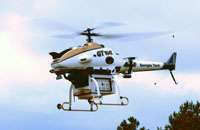Mini Helicopter Thinks for Itself

Unmanned aerial vehicles (UAVs) are one step closer to someday matching — and possibly surpassing — their human-piloted counterparts, thanks to the completion of a project successfully tested by Georgia Tech and sponsored by the Defense Advanced Research Projects Agency (DARPA) and the U.S. Air Force Research Laboratory. The project was supported by DARPA’s Information Exploitation Office with Dr. John Bay serving as the program manager.
Researchers from several partner institutions and organizations have helped to successfully build, test and fly the first rotary wing UAV, a helicopter called GTMax, with capabilities of flight control fault identification and reconfiguration, adaptive control and agile maneuvering — all operating on a single vehicle and under a single software architecture.
Collaborators on the project include Draper Laboratories, Vanderbilt University, Scientific Systems Company Inc., Oregon Graduate Institute, Honeywell Laboratories and Boeing.
The flight represents the completion of a DARPA/Air Force project to develop an innovative new software-enabled control (SEC) system with applications to UAVs.
Based on this UAV success, Georgia Tech has now been awarded funding for two follow-on programs for multiple UAVs in an urban warfare environment and for transitioning the technologies developed under the DARPA/Air Force program to military vehicles.
Advances in rotary wing UAVs are particularly important because of their requirement to take off and land in difficult terrain and restricted-size areas, such as ship decks, and their ability to hover while they identify and inspect specific locations. With traditional aircraft, a pilot with years of training and flight experience is on board to react to problems, threats and weather conditions, and current UAVs must be flown much more conservatively and have limited reaction capabilities.
Georgia Tech’s primary contribution to the overall project was continuing work started by Boeing on the new SEC system, an Open Control Platform (OCP), which gives the UAV the ability to reconfigure its software systems autonomously in flight.
The OCP is an object-oriented, real-time operating software architecture that can handle very large sets of data and computations in real time, similar to a pilot’s brain reacting to enemy fire or changing weather conditions.
The system also gives the UAV more agility to help avoid danger without exceeding critical flight parameters.
During the final test at Fort Benning, Ga., the GTMax used eight different low-level flight control systems and three guidance systems in a single flight, including adapting to primary flight control system hardware failures, environmental factors and changes in aircraft configuration.
The final tests on Georgia Tech’s UAV demonstrated several key advancements:
• The UAV is able to learn as it flies.
• The UAV is able to reconfigure after failures in primary flight control systems, including losing the ability to change the pitch of the main rotor.
• The UAV is able to automatically plan a route through obstacles.
• The UAV is able to maneuver aggressively.
• The UAV is able to fly using what it sees in its onboard camera, rather than using traditional navigation systems such as GPS.
• The UAV can be reconfigured in flight to select among several control and guidance systems.
The final experiment, recently conducted at the Military Operations Urban Terrain site in Fort Benning represents five years of collaboration between Georgia Tech’s School of Electrical and Computer Engineering and the Daniel Guggenheim School of Aerospace Engineering.
















